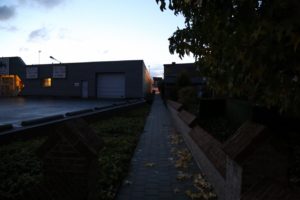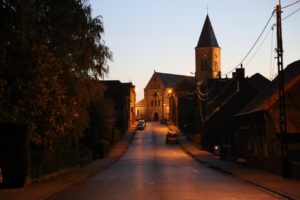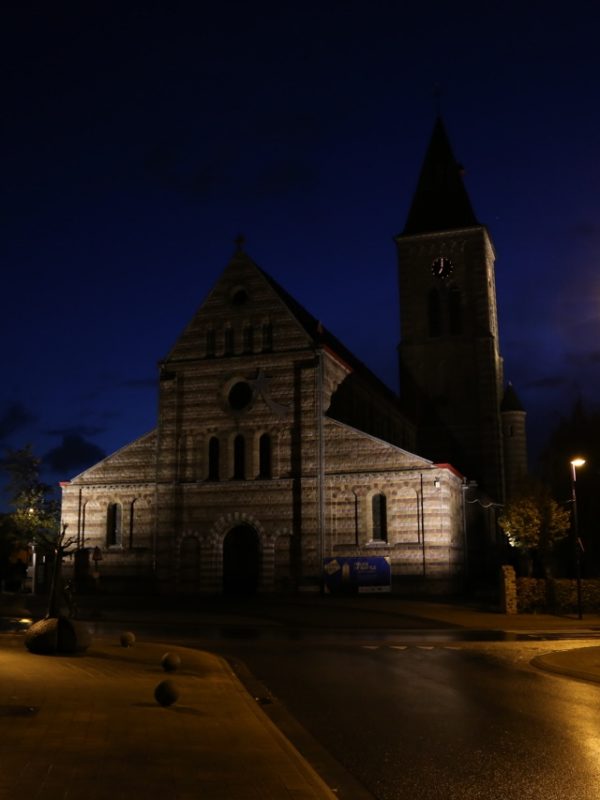In 2017, the weather has been wet and the night air has had a chill to it. Having got up early, I headed out of Ypres north-eastwards towards Passchendaele and ZERO HOUR. Making my way along the small roads which crisscross the fields which were the battlefield, it is only too apparent that this place is wet! Even with working drainage today, the roads and fields are littered with puddles in the waning, but nearly full moon. There is no one around these roads, whereas a hundred years ago, they would have been a hive of military activity.
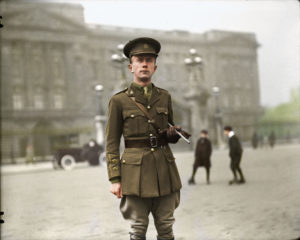
Lieutenant Josue Emile Dorey, outside Buckingham Palace on a trip to London after being commissioned in 1917.
This was the first time that my grandfather had been in command of a platoon in action since returning to the front after having been commissioned. The Battalion had been training for months, honing their attacking skills. No longer were the infantry attacking in open order and in successive waves. This time, smaller groups of men would attack, and when intermediate objectives where reached, other units would leap-frog them to the next objective to give the first unit a chance to consolidate and mop up. This was going to be a test for my grandfather!
Stopping on the road which is now called Canadalaan, I found the jumping off point of a hundred years ago, what is now a small footpath which runs between the two main roads and alongside a small supermarket.
Looking up Canadalaan towards the centre of Passchendaele and its church, two things are immediately apparent. One is the relatively short distance between that jumping off point and the church – it cannot have been much more than 200 yards or so. The other is that the road has a gentle upwards slope, after a slight dip immediately after that point. No doubt the Canadian troops would have encountered that dip just as they climbed out of their trenches and shell holes to start the attack, struggling in what would have been the muddiest part of the landscape totally destroyed by the previous fighting.
At ZERO HOUR, I started my walk up Canadalaan towards the centre of Passchendaele, the closest I could get to my grandfather’s route now that the area has been rebuild and developed. The church bells struck six and it was a poignant cue, just like the whistles a hundred years ago, that this was the start of my advance. I, however, did not have to struggle through deep and sticky mud under fire. Whilst the climb – no, you really cannot even call it a climb now – up Canadalaan isn’t arduous, somehow it felt as if it was. It seemed that I had to take each step of the way deliberately to reach the church and the main street of Passchendaele.
Unlike a hundred years ago, there was no one else around except one other early riser walking in the same direction (more about him later). In the couple of minutes that it took me to walk the distance which the men of the 27th Battalion had fought for at least and hour and a half in 2017, I thought what my grandfather was feeling. Scared is probably an understatement, but I know that his adrenaline must have taken over. He acquitted himself well and passed that first test of leading his platoon. That’s what the citation says which accompanied the award of a Military Cross that morning:
“For conspicuous gallantry and devotion to duty. He led his platoon with remarkable coolness, and when held up by a machine gun, he at once gave the order to rush the post, with the result that the whole crew of ten men were killed and two guns captured. His leadership and splendid dash during the attack were most outstanding.”
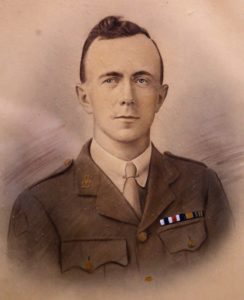
Lieutenant Josue Emile Dorey, M.C. He was awarded the Military Cross for actions on 6th November 1917 at Passchendaele
The War Diary of the 27th Battalion describes the action that morning as follows:
“Promptly at 6 A.M. our barrage came down commencing at 150 yards in advance of our front line. From there it advanced to the final S.O.S. line at the rate of 100 yards in 8 minutes except for one pause of 15 minutes on the centre of the village. The barrage could not have been excelled. The enemy immediately fired his S.O.S. His barrage was less than a minute in coming down but unfortunately for our assaulting troops it fell mostly in rear of the front line. Our men followed the barrage evenly and were controlled by their leaders.
It was found that the enemy had been occupying a line of shell holes less than fifty yards in advance of our jumping off trench. The effectiveness of our barrage was shewn by the fact it immediately put out of action the enemy M.Gs in his outpost lines. The garrison of these shell holes was dealt with. During the advance there was considerable opposition from M.Gs, particularly on our right, and the enemy kept up a steady rifle fire from the ruins of the houses on the main street of PASSCHENDAELE. the leading wave stayed at the first intermediate objective and the rear platoons “leap-frogged”. The advance was then continued through the village to the second intermediate objective where “leap-frog” was again carried out. The latter part of the advance was made to the final objective against little resistance other than enemy sniping. Observation had become good and a party of about thirty Huns were seen to be retreating over the open ground in front. Concentrated rifle fire was immediately opened (sic) them and a number of casualties inflicted. A small party of the enemy attempted to hold up our left flank with a machine gun near the final objective but were dislodged with rifle grenades and disposed of.”
Grandfather was on the right of the advance in the platoons of D Company so it is reasonable to believe that the reference in the diary and his citation are linked.
Anyway, back to the present, and having reached the church I went on a little further. Odd that it may seem, my steps seemed to be easier than the couple hundred yards on the other side. Yes, the ground does slope slightly away as you can now see clearly that Passchendaele church does sit astride a very small crest. But I don’t think it was that – perhaps it was just the relief that I had fulfilled the promise to be there exactly 100 years later than my grandfather. Even though I had never really had the opportunity of talking to him about his experiences before he died at the age of 84 when I was just a teenager, I did feel as if he had been with me in spirit today!
Finally on my way back to my car, I met the other early riser, also going back down Canadalaan. He is Nick Reeder, a Canadian who was doing a similar thing to me and commemorating a family relation who had also been there a hundred years ago with the 27th Battalion. He was Private Oliver W Ridley, who was killed that morning as he advanced into Passchendaele. Nick and I exchanged some stories and we will be in touch with each other as we explore our shared history of the 27th Battalion at Passchendaele.
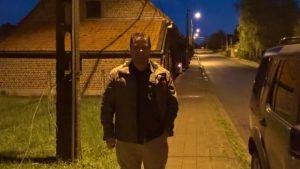
Nick Reeder, commemorating Private Oliver D Ridley, 27th Battalion Canadian Infantry, KIA 6th November 1917

